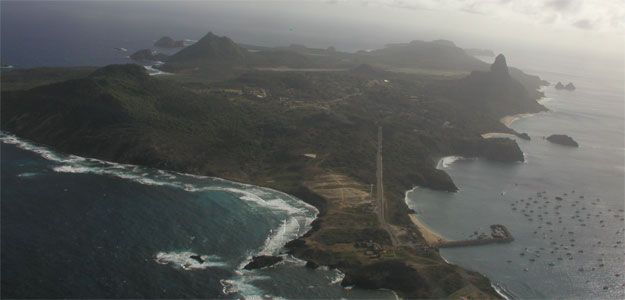
Brazil Moves Toward Protection
 For 21 years, Brazil has banned the killing of whales and dolphins on its coastline. As 2008 came to a close, it took
one step further by establishing its coastline as a sanctuary for these species, providing a major victory for conservationists
and a step toward increased ecotourism and scientific research. Will it be the tipping point for other nations in the region?
For 21 years, Brazil has banned the killing of whales and dolphins on its coastline. As 2008 came to a close, it took
one step further by establishing its coastline as a sanctuary for these species, providing a major victory for conservationists
and a step toward increased ecotourism and scientific research. Will it be the tipping point for other nations in the region?
By Fabricio Angelo
On December 18, 2008, the Brazilian government passed Decree 6698, establishing a sanctuary for whales and dolphins on the Brazilian coast. On the same day in 1987, the country banned the hunting of whales and dolphins along their coastline. For the coordinator of the project in Fernando de Noronha, Jose Martins da Silva Jr, the sanctuary doesn't go against any law currently in place. "It will encourage sustainable, non-lethal use of these charismatic animals, such as research, environmental education, and ecotourism," he said.
According to Jose Martins, the creation of the sanctuary has major political significance thanks to Brazil's influence on the International Whaling Commission, which is considering future plans including proposals for non-lethal use of whales and the creation of marine sanctuaries. "Whale hunting has always been common practice for some nations, including Brazil, which has contributed to 400 years of killing. The use of whales as a source of food and mainly fat almost led to the extinction of several species," he said.
According to Martins, Brazilian territorial waters are occupied by a high diversity of whales (including blue, common minke, humpback, pygmy, and sperm), who, being migratory animals, experience one or both of their life cycles in Brazilian waters. "Therefore, the protection of both local water as well as their routes of migration are fundamental for the survival of these large traveling mammals," he said.
The decree signed by the president turns the Brazilian coastline into a sanctuary for whales and dolphins, and aims to reaffirm the national interest in the preservation and protection of cetaceans and their use in non-lethal activities.
Brazil suffers from a high rate of capture and mortality among dolphins caught in fishing nets, particularly among the porpoise in Rio Grande do Sul, the river dolphin of the Amazon, and the gray dolphin in Maranhao, Para, and Amapa states. The massive depletion of their numbers has contributed to a rapid population decline, which is accelerated thanks to the low reproductive rate of dolphins, making them even more vulnerable to extinction.
A study by marine biologist Erich Hoyt in 2008 proved that dolphins are economically worth more alive than dead. In 2006, whale and dolphin watching took place in 91 communities in Latin America, bringing nearly US $278,000 into these areas. In Brazil, in 2006, 225,000 people visited to see dolphins and whales, bringing US $31,500 into the country. "These whales should be preserved for the sake of biodiversity. Since the early 80's when there were major investments in sustainable use- such as research, environmental education, and ecotourism- it's been possible to both maintain species and to achieve economic returns," said Jose Martins.
Kenia Valenca, coordinator of RMA (the Network of Atlantic Forest NGOs) and a director of GESQ (Study Group for Cetaceans and Turtles of Pernambuco), said that the signing of the decree is a landmark decision in the fight for the protection of whales and dolphins. "Everyone working in the marine are has fought a lot for this to happen. We believe that from now on the cetacean conservation movement will have much more support."
Kenia believes it is more important to sensitize the population about the imminent threats to these animals than it is to punish offenders. "This decree is the best way to attract attention from the public. Through it we will be able to ensure that international agreements are met. We are still evaluating how best to work with this decree, but surely the high point is the establishment of this sanctuary," she said.
Leandra Goncalves, the coordinator of Greenpeace's Brazilian office, said she was pleased with the publication of the decree. "This is an important step in the strategy of the Brazilian government to extend their conservation policies to cover whales and dolphins, since the hunting of these animals on the Brazilian coast has already been banned for 21 years."
According to her, Greenpeace believes that the decree is extremely important politically, especially internationally, since Brazil is one of the leading forces for preservation in the International Whaling Commission. "We hope that Brazil will continue working vigorously in this direction by proposing strong measures against the hunting of these animals. The goal is to have, together with African countries, Argentina, and Chile, an area of even larger protection- a sanctuary of the South Atlantic," Leandra said.
Fabricio Angelo is a journalist with Rebia, the Brazilian Network for Environmental Information. Photo Corutesy of Magglz. This article has been printed with the permission of Ecoagencia news network. A copy of this article in Portuguese can be found at: midiaemeioambiente.blogspot.com/2008/12/costa-brasileira-vira-santurio-de.html


